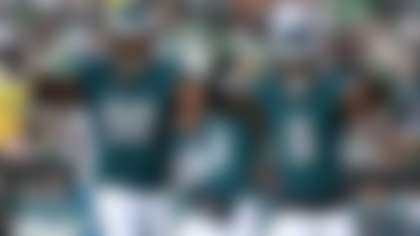Super Bowl LIV feels like the most compelling title game matchup in years, with the San Francisco 49ers taking on the Kansas City Chiefs. Both teams feature a dynamic offense, but they take different approaches to lighting up the scoreboard.
The 49ers field an old-school ground-and-pound attack, with a dominant running game complemented by an efficient quarterback who can make big-time throws in key moments. Although Jimmy Garoppolo hasn't been asked to chuck it much in the playoffs, he put together a highlight reel of pinpoint passes during the regular season with games hanging in the balance. Meanwhile, the Chiefs' offense is fueled by a generational passer who distributes the ball to a collection of playmakers with the speed and explosiveness of an Olympic track team. Patrick Mahomes' exceptional arm talent and limitless range enable Kansas City to score from anywhere on the field at any time. Defensively, the 49ers are powered by a star-studded line that features five former first-round picks in the rotation. The Chiefs' D has been sparked by the re-emergence of Tyrann Mathieu as the ultimate playmaker in the secondary.
With so many blue-chip players set to take the field on Sunday in a game for all the marbles, I wanted to outline a five-point blueprint to victory for each team. Here's what Kansas City needs to do in order to hoist the Lombardi Trophy:
1) Just let Patrick Mahomes be Patrick Mahomes.
It's easy to see why Kansas City torches defenses across the league when you pop in Mahomes' tape over the past two seasons. The reigning league MVP is a generational talent playing the game at a level that few have reached at the position. Mahomes is currently the highest-rated passer in NFL history at 108.9 (min. 1,000 attempts) and he's led the Chiefs to 32.6 points per game in his starting career, which is the highest figure for a quarterback since 1950 (min. 25 starts). In addition, he's one of just four quarterbacks in the Super Bowl era (along with Garoppolo, Joe Montana and Tom Brady) possessing a winning percentage of .700-plus and a passer rating of 90-plus.
With all of that in mind, Kansas City needs to just put the ball in Mahomes' hands and let him go to work on the 49ers' defense. I know the thought of throwing the ball all over the yard against the NFL's top-ranked pass defense might sound crazy -- after all, San Francisco allowed just 169.2 passing yards per game during the regular season -- but the Chiefs are at their best when No. 15 has the freedom to play sandlot football from the pocket. Mahomes boasts the best career postseason passer rating (115.0) and touchdown-to-interception ratio (11:0) by any player in the Super Bowl era (min. 125 pass attempts). Most importantly, he has the most pass attempts without an interception (142) to start a postseason career since at least 1991.
Considering the Chiefs have eclipsed 30 points in all four of Mahomes' career playoff games, I expect Andy Reid to put together a "First 15" script that enables his QB to get into a rhythm quickly. The opening plays will likely feature a handful of RPOs (run-pass options) and some screens to get the ball out of Mahomes' hands quickly before San Francisco's pass rush can get home. Additionally, Reid will throw in a shot play or two to see if he can catch one of the 49ers' young defenders napping on the job.
After assessing how the Niners are playing Mahomes, I expect to see Reid work off the second sheet on the menu to counter the man or zone tactics employed by Robert Saleh. If the 49ers remain in their zone-based coverages, Kansas City will continue to pepper the defense with quick-rhythm throws designed to get the ball to Tyreek Hill, Sammy Watkins and Travis Kelce on the perimeter within the voids between linebackers and safeties. The "catch, rock and throw" tosses could produce big gains if San Francisco fails to make solid tackles in space. Against man coverage, the Chiefs would feature more of their shallow-cross package, with an assortment of receivers zipping across the field after using rubs or picks to shake free from defenders at the line. Considering Kansas City's collective team speed, the 49ers might be leery of playing a lot of man-to-man, unless Mahomes is shredding their zone concepts.
Regardless, Reid should let his MVP-caliber quarterback drive the bus in this matchup and see if the 49ers can stop him.
2) Make the game a track meet.
Reid has assembled an Olympic track team on the perimeter, with Hill, Watkins, Kelce and rookie Mecole Hardman comprising the Chiefs' 4x100-meter relay. The collective speed and explosiveness is jaw-dropping, and most defenses are unable to trot out a secondary with the capacity to run with Kansas City on the perimeter.
With that in mind, the Chiefs should test the speed of the 49ers' secondary with a variety of formations and route combinations that put defenders in isolated matchups on the perimeter. Whether it is utilizing more 3x1 formations with Kelce positioned on the back side or moving Hill inside to the No. 3 position on the strong side, the Chiefs have the capacity to target specific defenders and exploit their vulnerabilities in space.
In Kelce's case, the isolation game has helped him dominate on the perimeter this season. K.C. has isolated No. 87 more than any other qualified tight end in the league (26.1 percent of the time, per Next Gen Stats), with Kelce catching 32 of 45 targets for 452 yards and a touchdown -- numbers that equal a sparkling 125.8 passer rating. The Chiefs have balanced out their isolation game, too, with Kelce running 78 isolated routes on the left and 75 on the right.
With the Chiefs also capable of putting Hill in various spots to take advantage of certain Niners cornerbacks (Ahkello Witherspoon, Emmanuel Moseley or K'Waun Williams), the big play should be available to No. 10. Since 2017, Hill has 41 deep-ball receptions (20-plus air yards) for 1,715 yards and 15 touchdowns -- all marks that lead the league, per Next Gen Stats. In his four-year career, the guy has 21 touchdowns of 40-plus yards; and then there are the 13 plays of 50-plus yards on a variety of deep passes, catch-and-run plays, reverses and returns. Long story short: Hill is a threat to score from anywhere on the field. Kansas City should make a concerted effort to get him at least 10 touches on Sunday.
To get Kelce and Hill in prime position to impact the game, Reid should utilize a variety of formations, shifts and motions early on, enabling Mahomes to identify the favorable matchup and check into a play with home run potential. This is how the Chiefs have exploited defenses since Mahomes' insertion into the starting lineup, and I would expect them to continue this approach against a defense that's a little suspect in the back end.
From a route-concept standpoint, the Chiefs can make the game a track meet by dialing up plays that put their fastest players on the move horizontally and vertically. By featuring more "on the run" routes (crossers, diagonals and vertical patterns), Reid can put his top playmakers in ideal positions to run away from speed-deficient athletes on the perimeter. In addition, the Chiefs could sprinkle in some of their deadly screen game plays (slow screens, bubble screens and WR screens) to a set of dangerous playmakers. The cumulative effect of chasing ball carriers from sideline to sideline could tire out a defensive line that has overwhelmed opponents to date.
Finally, the Chiefs should consider playing at a faster pace and utilizing tempo to their advantage. By using a little more no-huddle, Kansas City can wear down San Francisco and exploit a tired defense in the second half.
3) Force Jimmy Garoppolo to beat you.
Despite owning a 21-5 record (including the playoffs) as the 49ers' starter, Jimmy G is viewed as the team's biggest question mark, based on his minimal contributions throughout the postseason. Over San Francisco's two playoff wins thus far, Garoppolo has completed 17 of 27 passes for 208 yards with one touchdown and an interception, posting an 83.6 passer rating. He is just the third quarterback to lead his team to the Super Bowl with two-plus starts and fewer than 30 pass attempts in a postseason, joining Earl Morrall (1972) and Bob Griese (1973). Jimmy G has not attempted 30-plus passes in a game since the 49ers' Week 15 loss to the Falcons. Think about that: The Niners' QB1 hasn't really been tasked with winning a game on the strength of his right arm since mid-December, yet San Francisco has won four straight games, with the ground attack largely paving the way. Considering the potency of San Francisco's running game, the Chiefs have to make the NFC champs play left-handed, which means stuffing the run and forcing Garoppolo to throw the ball when everyone in the stadium knows that he has to throw.
Although Garoppolo has been efficient as a passer this season -- as evidenced by his top five rankings in completion percentage, yards per attempt and passing touchdowns -- he has 14 interceptions and 19 total giveaways. That's a significant number of turnovers, particularly when you consider his limited pitch count. In the seven games this season where No. 10 finished with 30 or more pass attempts, the 49ers posted a 5-2 mark, but Jimmy G totaled 11 turnovers in those contests. I'm not a mathematical genius, but it's pretty clear that a defense's odds of generating negative plays certainly increase when Garoppolo is forced to throw the ball more. Additionally, the move to a pass-centric offense will make it tougher for the 49ers to control the tempo (time of possession) and likely result in Super Bowl LIV turning into a fast-break basketball game on the grass. Considering K.C.'s offensive firepower, a game with more possessions benefits Reid's squad.
As far as forcing the Niners to throw more in Super Bowl LIV than in their previous playoff games, it will come down to the Chiefs' ability to stymie San Francisco's running game. Despite Kansas City's lackluster regular-season ranking in rush D (128.2 yards per game, which ranked 26th), Steve Spagnuolo's unit clamped down in the stretch run. After allowing 148.1 rush yards per game (with five 100-yard rushers) over the first 10 outings of the season, the Chiefs have given up just 93.6 rushing ypg (with one 100-yard rusher) over the past eight contests. That's a significant reduction over the past few months.
To slow down the Niners' running game, Kansas City will need to use more "plus one" defensive fronts to clog the gaps at the line of scrimmage and limit the explosive runs from San Francisco's cavalcade of backs. Although the 49ers have the second-most rushing touchdowns against eight-man fronts (14), the team only averages 3.9 yards per attempt vs. such defensive alignments. With Tyrann Mathieu or Daniel Sorensen hovering around the box as an extra defender, the Chiefs' extra bodies could thwart the Niners' rushing attack and put the game on Jimmy G's shoulders.
4) Match San Francisco's physicality and toughness.
There isn't a statistic available to quantify the importance of physicality and toughness in the playoffs, but old-school coaches will tell you that postseason games typically go to the team that sets the tone with big hits throughout the contest. Despite an understandable emphasis on player safety in recent years, football remains a contact sport and substantial collisions change the way quarterbacks and skill players perform. If the Chiefs are going to knock off the 49ers, they must be able to deal with San Francisco's ferocious, relentless style. The Niners fancy themselves as the "bullies on the block," and their championship recipe (strong running game and stout defense) perfectly plays to their identity.
Just pop in the 49ers' most recent games, and you can see how their rough-and-tumble style wears out opponents. From Nick Bosa, Arik Armstead, DeForest Buckner and Dee Ford pummeling quarterbacks at every chance to Richard Sherman and Co. harassing pass catchers all over the field to San Francisco's fullbacks, tight ends and wide receivers blocking defenders from snap to whistle, the 49ers want to make you feel them for the full 60 minutes.
In many previous title games, we've seen rough-and-rugged teams impose their will on finesse squads: Patriots over Rams in Super Bowls LIII and XXXVI, Seahawks over Broncos in Super Bowl XLVIII and Giants over Bills in Super Bowl XXV, to name a few. The constant harassment and pounding from the bullies took its toll on the opposition and resulted in the aggressive team hoisting the Lombardi Trophy.
Studying these Chiefs on tape, they're certainly more finesse than physical on offense, with a pass-first attack that places a premium on speed and skill. The 49ers will attempt to slow down Kansas City's weapons by jamming, clutching and grabbing them whenever possible. The constant harassment is designed to disrupt the timing and rhythm of the passing game while also frustrating explosive athletes who prefer to play in space. K.C.'s skill players must be willing to fight through the contact and earn their yardage with gritty play on the perimeter.
Defensively, the Chiefs have shown the football world that they can slow down a punishing rushing attack in the playoffs, having just held Derrick Henry to 69 yards rushing on 19 carries in the AFC title game, but this San Francisco running game is a soul-snatcher. All 11 Chiefs defenders will need to be willing tacklers to stop Kyle Shanahan's brainchild. The individual and collective discipline required to stop the scheme will tax the Chiefs' minds, and the rugged style of the 49ers' runners and blockers will test the Chiefs' courage.
If Kansas City is going to get past this San Francisco squad, the Chiefs must commit their minds and bodies to winning a heavyweight fight against a team that's built to play like Deontay Wilder.
5) Manage the game wisely.
Reid deserves all of the praise he's getting for guiding a second franchise to the Super Bowl. That said, over the years, the head coach has struggled with some of the managerial aspects of his gig on game day. Reid's teams haven't always acquitted themselves well with situational awareness, clock management and timeout usage. Not to mention, costly penalties in key games. (Remember Dee Ford's catastrophic offsides penalty in last year's AFC title game?) The Chiefs' lack of attention to detail has shown up again in this year's playoffs, too.
During the disastrous start to the Divisional Round, Kansas City had one punt blocked for a touchdown and two returns muffed (though they only lost one). Then, in the AFC title bout, the Chiefsfailed to defend a fake punt in an obvious fake situation. They've also extended opponents' drives with ill-timed encroachment penalties, failing to play the kind of clean football (minimal turnovers and penalties) that is typically required to win in the postseason.
That's why the Chiefs better have conducted a few situational-awareness reviews on the practice field throughout this week, and they'll need to issue multiple reminders to their units during the game. Whether it is a coach taking charge and reminding the troops prior to running onto the field in various situations or a team captain or squad leader barking out commands, Kansas City must be aware of down-and-distance, clock and score and critical-down tendencies at all times.
For Reid specifically, he must manage the game well as a play caller, maximizing his team's offensive potential while simultaneously minimizing the risk for his defense. Depending on how things play out, this could require Reid to call more runs to burn up some clock and keep the ball away from the 49ers' offense, or it could prompt the offensive wizard to speed up the game to wear down San Francisco's defensive front.
The 200-game winner must also determine when to take a calculated risk on fourth down (fake punt or gadget play) versus playing it safe with the game hanging in the balance. With the potential for a crucial two-minute drill in a Super Bowl matchup that feels like a toss-up, Reid's play selection and reminders could be the difference between scoring a game-winning touchdown and watching the clock run out on the Chiefs' championship dreams.
Follow Bucky Brooks on Twitter @BuckyBrooks.












